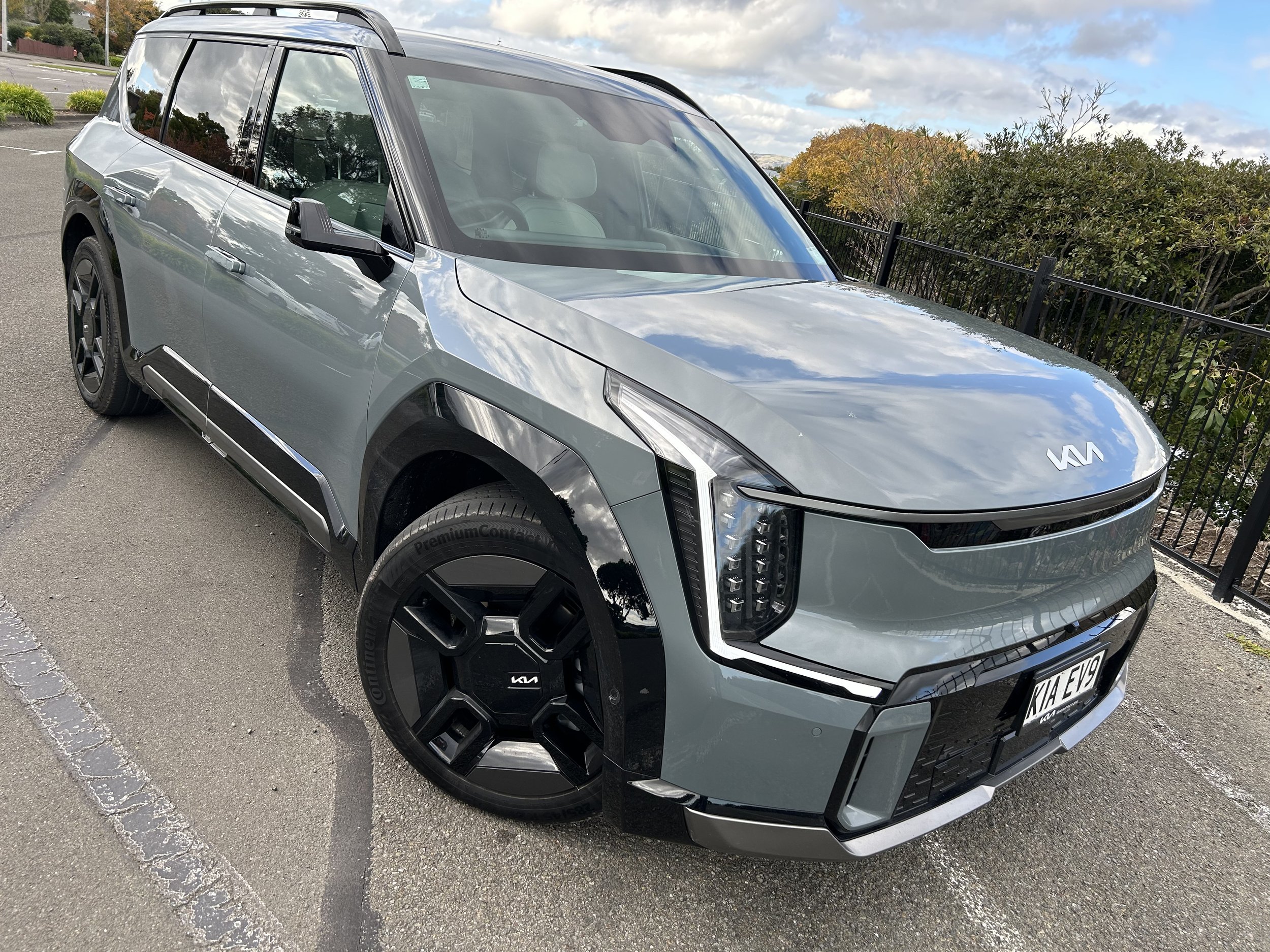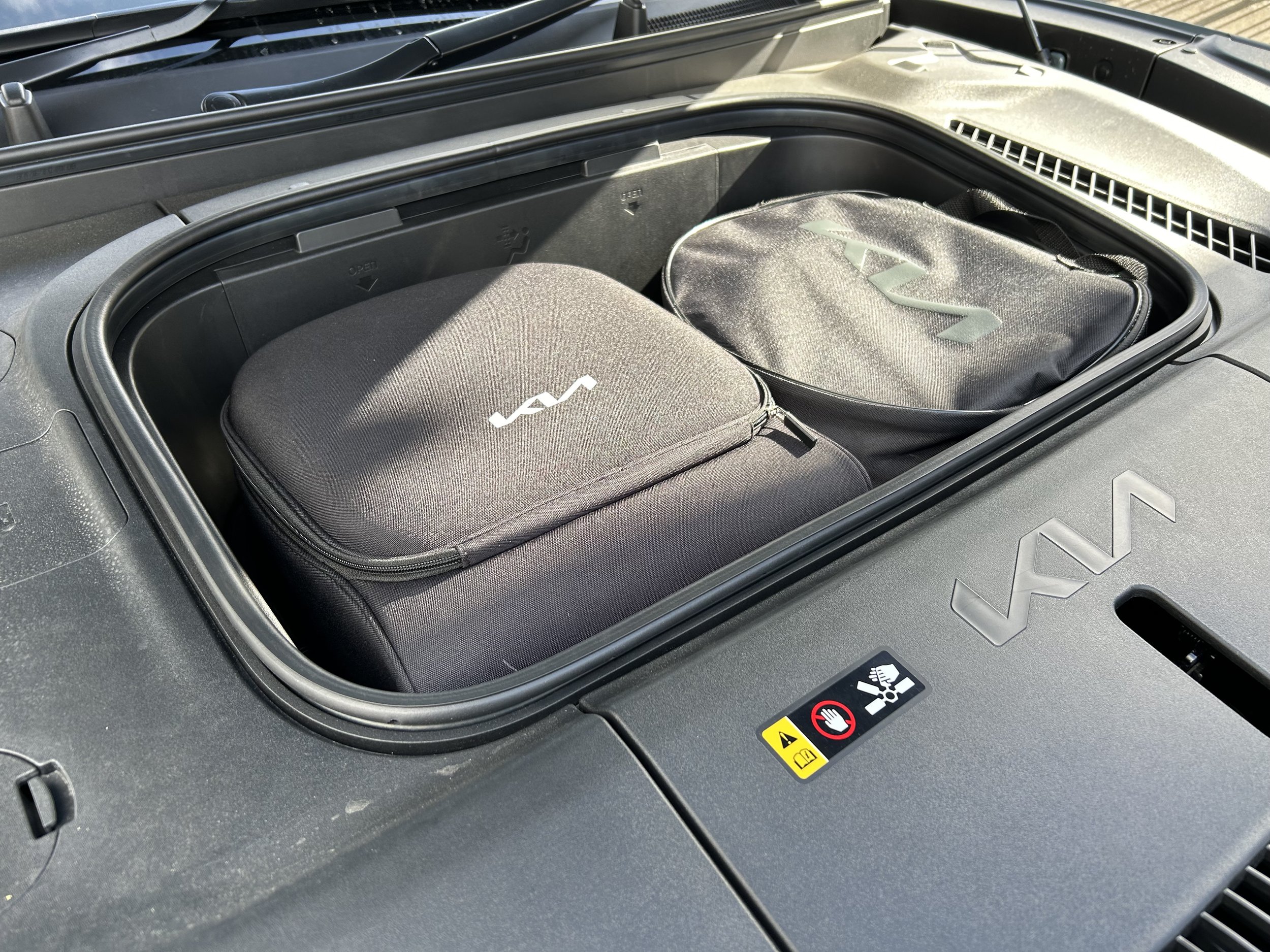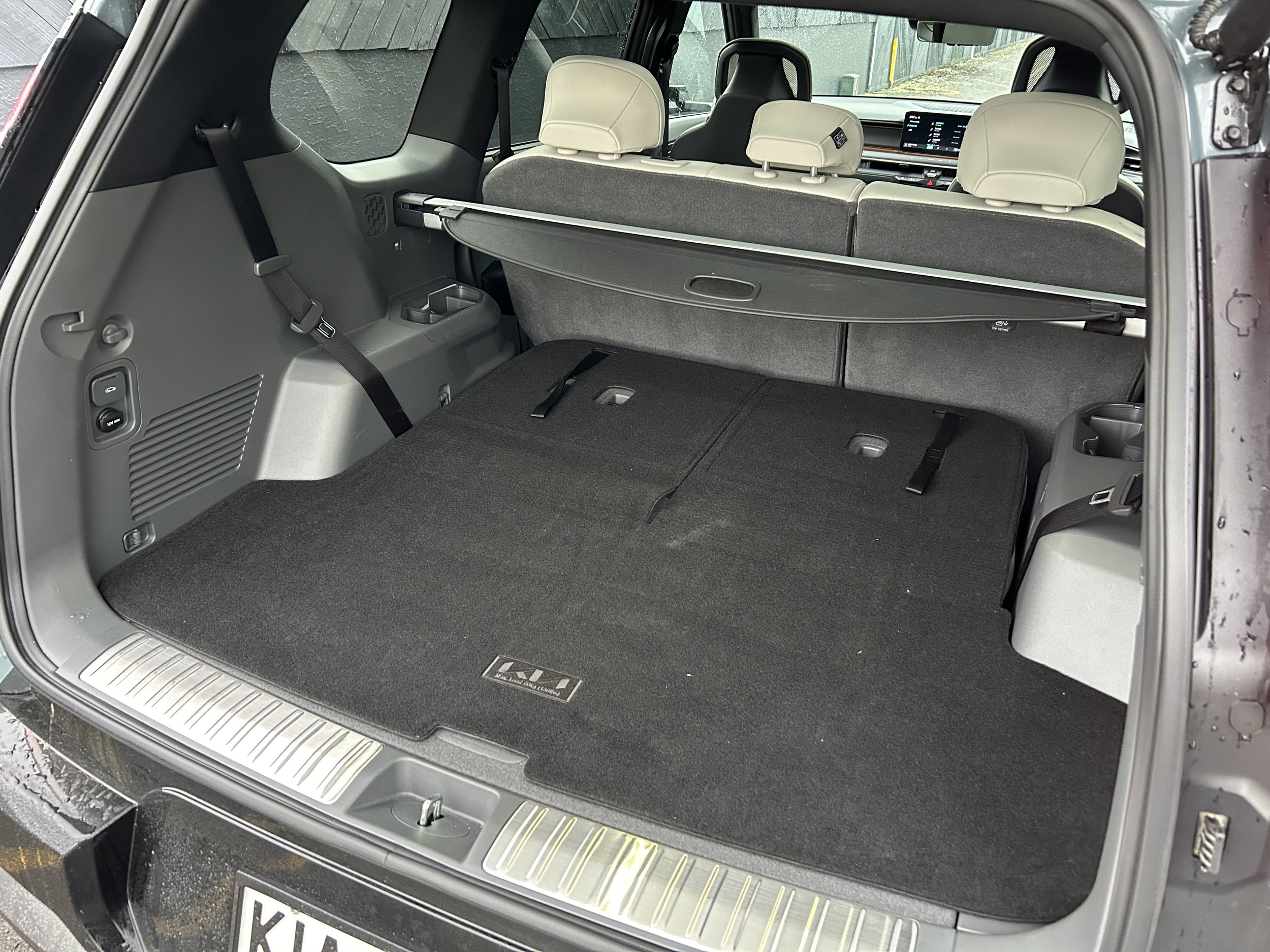Kia EV9 GT-Line road test review: Giant steps
/As EVs get bigger, so do ambitions and expectations.
How much: $134,990.
Drivetrain: Twin electric motor, 282kW/700Nm, direct drive, 99.8kWh battery.
How big: 5015mm long, 1980mm wide, 1780mm tall.
We like: Assured performance; retro-futuristic style; comfy cabin.
Not so much: Hefty price; over-zealous speed limit warning.
SOME electrics genuinely chart new territory, others stand as alternates to existing internal combustion choices that might still make sense.
Conceivably, that’s the Kia EV9. Genuinely brilliant, a technology masterpiece and, yet … elephant in the room.
Multi-seater people-carrier are the most sensible of formats; the kinds of cars whose purchase least driven by passion and more by pragmatism.
With that in mind, anyone in the hunt for one from this South Korean make can surely not help but notice it still has the Carnival. Functionality-wise the same thing, serving in almost the same size, but with internal combustion.
Would you cross-shop? It’s true that often EV commitment, once made, tends to be final. Plus the EV9 is kind of a part-timer people carrier. It’s actually classified as a SUV. Some have called it Korea’s Range Rover; I wouldn’t, but will agree the only other fully electric EV9 equivalents are fully premium, the main one being the Mercedes Benz EQS SUV that sits in a higher price bracket again.
Even so. If you went shopping EV9 … and if you spied the Carnival? Well, I could imagine that being a scenario that might, just might, create disturbance in the force.
With dollar differences being debated, going electric simply becomes a massive test of faith. You’re going to save at least $26,000 if buying base electric and top line fossil, rising to $45k if respective flagships come into play. The latter would buy a small electric car.
So maybe the EV9 is a great idea arriving a touch too soon. But that’s not to say it’s not a great idea.
It is – quite obviously – a big car for Kia. In design and especially at technical level, it has rolled in as a tour de force, ticking boxes beyond usual expectation. It’s really a landmark achievement.
One aspect that hung with me long after the test ended was just how something so large could simply feel so unstressed. This model is on the same platform and has the same drivetrain as the five chair, ‘four-adults-in-comfort’ dual motor EV6. Yet is considerably larger, heavier and, of course, seats seven.
But would you ever know it from the driving? It’s a huge testimony, surely, to the positives of electric power that by and large it simply didn’t seem any less effortlessly muscular than the EV6; not just with two occupants but even when all pews were filled. You’d require a very large capacity, or at least extremely torque-rich, internal combustion engine to achieve the same sensation. The Carnival’s good, but not in that club.
It goes big on styling as much as anything else because it’s a statement of pride. Kia has come a long way in the last decade; arguably further than Hyundai, with which it ties. The past 24 months and those ahead seem to be very much it’s time. So why not roll out product that is unapologetic in its boldness?
As of Korea’s largest road cars it’s potentially a bit too big for its own good in some circumstances. At more than five metres in length and almost two metres wide, it could be considered the box the EV6 and forthcoming EV5 came in.
Squeezing such a sizeable footprint into a drive-through might require careful thought, and assists are appreciated when parallel parking. Kia provisions an automated parking function that allows owners to move the car directly forwards or rearwards in or out of a parking space remotely via the key. Helpful if you have a narrow garage or somebody has parked that bit too closely next to you; you just need get over that weighty element of ‘what if?’ trust.
As much as that size might occasionally daunt, it also delivers abundance in respect to roominess size. That, plus its technology - both safety-related and for convenience - and, most importantly, a large capacity battery to give it plenty of driving range and you have a car that stands out in every sense.
Big cost, though. No arguing, it is. The sensible way to save some spend is to bypass the top of the tree GT-Line on test and take to the mid-level Earth that’s(pun intended) far more grounded, for $18k less. It hasn’t quite the same range - which seems odd, because the drivetrain is identical and runs less draggy 19 inch wheels - but will still deliver at least 400kms between charges.
Otherwise the only sacrifice is of some plush touches. That’d be okay with me. Sure, the GT-Line is wonderfully comfortable; it has superb front and second row seats. But it also has stuff that seems a bit vestigial to its primary cause.
Cameras in place of wing mirrors, seat heating and ventilation for the first and second row of seats, a premium Meridian audio system … they all add ultra-premium flair and are great to crow about. But none are anything you’d absolutely need if daily duty was simply shifting icky-fingered kids and pets and groceries.
The camera-based door mirror system is a great example of motor show wow that struggles in real life circumstances. While the display is very high resolution, it lacks depth of field, so it’s really hard to accurately judge distance.
When reversing, that’s okay because you have plenty of sensors and reversing camera view on the centre screen, but when pulling out to overtake can be hairy (even with radar that warns of traffic approaching from behind). Plus you just know that, sooner or later, if you park this thing in the wrong place, some idiot is going to smash off the cameras for giggles.
You can see why Kia designers pushed for those; the car’s look in entirety expresses Tron-level tech. Those bejewelled LED headlights with two vertical columns of six square LED units in themselves make a massively strong sci-fi statement in anyone’s rearview mirror.
The exaggerated proportions are helped by chunky wheel arch extensions, finished in a contrasting gloss black paint, framing those big wheels. The door handles retract inwards when locked to clean up the airflow and overall look.
The obvious beauty of this architecture is that it allows the wheels further outwards to increase the wheelbase to an almost stretch limo-like 3.1 metres, which is primarily to free up interior space though, to my eyes, it also makes the exterior proportions work better. Another benefit of the big box effect is to also allow for a massive glasshouse; much better than is usual even for seven-seaters, some of which offer poor outward visibility from the rearmost row. Not this one.
As much as it is the epitome of what we used to call people carriers, luggage consideration is also reasonable. The boot is unencumbered by the two bags of charging gear - they fit into the frunk in the nose - and when the luggage cover is detached, it slots under the boot floor (there’s a trick to this).
Standing up the third row makes it tight for cargo but not too bad; even with all chairs in place, you get a clean rectangular area delivering 312 litres’ of volume. When the third row isn't required, drop them. Space swells to 828 litres. With only the front two seats in use, the Kia can swallow a small-van-like 2393 litres.
Kia NZ could have ordered the GT-Line with six seats rather than the seven it gets; the smaller count would replace the middle bench with individual chairs that swivel through 180 degrees. It seems posh enough to have warranted this and I’ve read an ability to swing through 90 degrees would be good news to well-heeled parents of smaller children, as it makes it far easier to access a child seat when it's facing directly out the door.
Greeting the driver is a comprehensive digital dashboard comprising a pair of 12.3-inch displays sandwiching a smaller 5.3-inch unit that features the climate control settings. Pleasingly, there are still chunky physical toggle buttons on the leading edge of the centre console for adjusting temperatures and fan speeds. Menu shortcuts are printed across the haptic dashboard facia. Android Auto and Apple CarPlay avail wirelessly.
Within the centre console between the front seats is a pair of cup holders, a wireless charging pad and a button cluster, with more on the doors.
Interior build quality is stunningly good, from the quality of the materials to the assembly. You’d expect a big box to have at least one of two rattles, but not a one in this well-driven example.
As said, the size of the EV9 is noticeable when you drive for the first time, the second time and … oh yeah, pretty much all of the time.
Still, driving it is a pleasing experience, so long as you accept that because of its lane-filling bulk it’s better treated as a product in which you want to imperiously sit alone, without too much expectation of it scything through bends. But that’s fine by me, and will be fine by your passengers.
As with many large electrics, there is a definable firmness to the suspension. Yet the ride quality is barely ever uncomfortably harsh. The combination of most weight being positioned low down means you can feel its low centre of gravity when cornering, but having all-wheel drive allows it to also be surefooted and stable, too.
News that there’ll be a full-blown GT edition at some point is intriguing. You really can’t see it as a track-fettled car. As much as the multi-link rear suspension setup contributes positively to the handling, overall this vehicle is about delivering quality and refinement to make distance driving all the more pleasant.
I can imagine Carnivalists being envious of the battery-fred choice when they experience just how refined and comfortable it is.
Supreme quietness is a trait of many EVs, but it is emphatically all the more accentuated here. It might be a big interior space, but this car is truly library-hushed on smooth tarmac. Yes, coarse chip invariably creates some tyre roar, more’s the pity. But overall it’s highly accomplished and a credit to effort put into sound-proofing, which includes using acoustically optimised front glass.
EV maker’s range estimates are sometimes widely awry n real world. The 99.8kWh (usable) battery here having fair chance of meeting the cited WLTP combined driving range of 512 kilometres obviously asks for a lighter foot than I have; after clocking 340km on the open road, it was time to replenish.
Handily, it was from a 300kW hyper charger; Kia being at the sharper end of the battery technology race means it equips this car with a 210kW DC-charging capability. It was back from 10 percent to 80 percent in next to no time.
Provision of V2L (vehicle to load) capability as well, to power external devices such as power tools or camping equipment, is also a nice idea. Kia also has built-in preparation and compatibility for V2G (vehicle to grid), V2H (vehicle to home) and V2B (vehicle to building), meaning that it can make energy from the battery available to external locations when plugged into a bidirectional charging unit, as and when that’s allowed.
Where you do need some patience is with how the raft of safety systems pertaining to driver attention operate.
Kia (and Hyundai) feel compelled now to install a warning system that bongs any time you go beyond the posted speed limit, which is well-intentioned but a very real distraction.
Some manufacturers make this relatively easy to disable but in the EV9 it’s several levels deep in the screen menus, and it resets every time you turn the car back on.
You find it hard to do anything in this car without drawing wrath from the driver attention monitoring. This is operated by a front-facing infrared camera that’s incredibly zealous to its duty; it will chirp an alert to request that you pay attention to the road for anything …
I got off to a poor start with this car in deciding to alter the HVAC and audio after starting driving, rather than before. The touch-sensitive shortcuts integrated into the dash below the screen for the first asked for several stabs before they worked, which prompted huge disapproval from the all-seeing electronic overlords.
An interesting credential for the EV9 is its off-road function. It’s an aptitude that, with all due respect, needs to be considered carefully. As much as some UK publications have taken to suggest this is a Range Rover altrernate, the weight, the low ride height and the clearly road-tuned rubber all say otherwise. Mind you, perhaps it’s the potential alone that counts. My neighbour has a Range Rover that’s more likely to go to the Moon than to hit serious mud.
The biggest challenge with EV9 is the cost. Top-tech electrics (which any 800v product is) are expensive, that’s a fact. Also, we get that Kia has ascended from being Korea’s ‘value’ brand; gone, pretty much, are the days when it won attention by selling a cheaper kind of Hyundai. Without an equivalent in the market from that semi-parent (it’s coming, at some point), it’s hard to get a handle on how much fat there is to those stickers. With EVs in a sales mire generally, this is the best time to find out.























